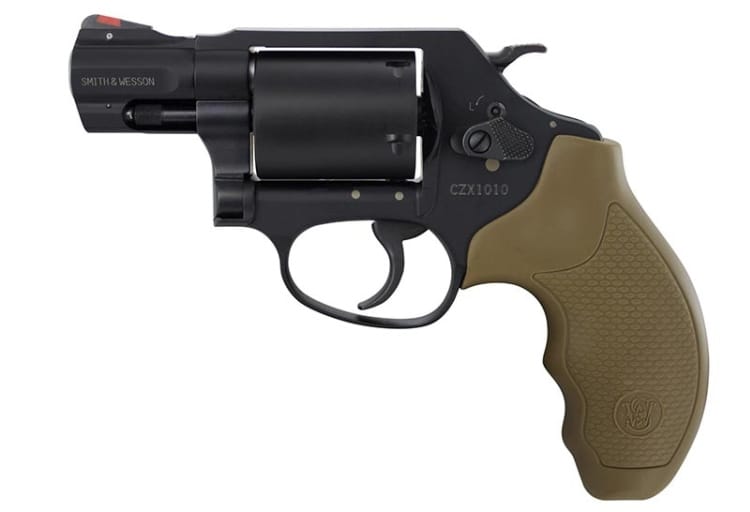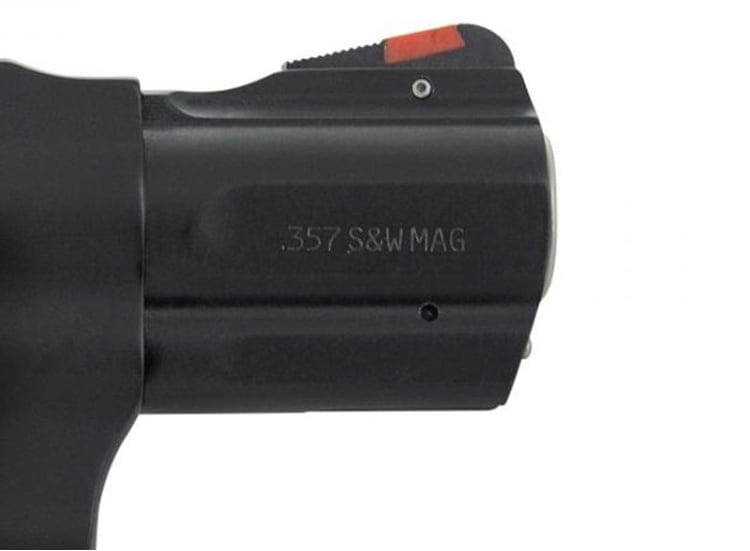Smith & Wesson announced the company is now shipping the new Model 360 revolver. This new J-frame wheel gun is a bit unusual in that it, as a “plain” Model 360, joins the Model 360 PD that is already in the company’s catalog.
The New 360 Revolver
The just-released revolver is a 5-shot handgun that is designed for the .357 Magnum cartridge. As with most .357 Magnum handguns, this revolver will also shoot .38 Special loads including the +P variety.
It is built on the company’s J-frame. This is the current small frame used for the more diminutive Smith & Wesson wheelies. Unlike many of the J-frames built of aluminum, this one uses a scandium alloy.
For the non-chemistry crowd, scandium is a naturally occurring element, not a marketing name. While offering a lighter weight frame at a similar strength level when compared to a typical aluminum alloy, scandium alloy tends to be a bit more expensive. The simple reason is scandium is not as common an element as iron, aluminum, and some other metals. In fact, it is often extracted from deposits of uranium and rare earth ores.
The use of scandium, therefore, drives the price up and the weight down.

It’s been my experience that Magnum loads really kick with featherweight revolvers like this one. I am not suggesting that this gun is going to be uncontrollable.

Smith & Wesson uses a black PVD finish on the gun. PVD, or particle vapor deposition, is a metal finish that has been growing in popularity in the gun industry. It allows a company to apply a wide range of colors to a firearm while also providing good durability and corrosion resistance. In the past, S&W has not used PVD extensively. I wonder if we will see more PVD finishes from it in the future.
Offsetting the black finish is a set of two-piece rubber grips that are flat dark earth in color. The grips used on this gun are longer than the standard boot grip used on many of the small revolvers from Smith & Wesson. For most shooters, this means you can get a full firing grip on the gun.

Unfortunately, the Model 360 revolver has the internal lock that Smith & Wesson installs on most of its modern revolvers. While the problems with these locks have been largely overblown, all of the problems I have read about have come from the lightweight guns. Hopefully, the problems have been completely resolved and will not create any issues with this gun.
The “Other” 360 Revolver
Still in the company’s catalog is the Model 360 PD. The gun is very similar to the original Model 360 (also referred to as the Model 360 SC) that was introduced at the 2001 SHOT Show. That original model was discontinued leaving only the 360 PD as a current production model.

With such a lightweight revolver, recoil is increased. Due to the increased recoil, light bullets can actually “jump” their crimp and “walk” out of the case. If a bullet moves very far forward, it can lock the cylinder up and prevent the gun from firing. For this reason, Smith & Wesson states only loads with bullet weights of 120 grains and more be shot from the 360 PD. The same warning was given for the original Model 360. I would also add that if you are shooting hand loads, make sure you are crimping correctly.
Bullet walking appears to have been eliminated in the newest Model 360 as the warning is not given on it. I suspect the few extra ounces of weight is enough to prevent this condition.
Increased recoil also translates to the shooter. I’ve shot one of these with full power 125 grain .357 Magnum loads, and it does bark. However, it is completely controllable and accurate. It would overwhelm a new shooter, so please don’t hand one of these to a novice. It could turn them off to shooting completely.

The final major difference between the two guns is that the PD model is significantly more expensive: $1,019. The titanium cylinder is largely responsible for that price increase.
The Forgotten 360s: M&P360 and Kit Gun
There are a pair of longer barreled Model 360 revolvers that briefly made an appearance in the Smith & Wesson line, but they have since been discontinued. One was the M&P360 and the other was the Model 360 Kit Gun.

For this gun, Smith & Wesson went with a Standard Dot tritium front sight from XS Sights. This gave shooters a glowing night sight from the factory if they desired one. The gun had a black PVD coating and the same size grip as the new Model 360.
Another longer barreled gun was the Kit Gun version.

* Smith & Wesson’s sale sheet on the M&P 360 revolver shows the gun was launched in July of 2009. However, the 4th edition of the Standard Catalog of Smith & Wesson states the gun was shown at the 2007 SHOT Show. It is possible that an early prototype was on display at the SHOT Show, but that the gun did not ship until two years later.


